实验4:Unet眼底血管图像分割
一:实验目的与要求
1:掌握图像分割的含义。
2:掌握利用Unet建立训练模型。
3:掌握使用Unet进行眼底血管图像数据集的分割。
二:实验内容
1:用Unet网络完成眼底血管图像数据集的分割任务。
2:可视化比较Unet、Unet++的分割效果。
3:尝试调整网络参数提高模型的分割精度。
三:实验环境
本实验所使用的环境条件如下表所示。
操作系统
Ubuntu(Linux)
程序语言
Python(3.8.10)
第三方依赖
torch, torchvision, matplotlib,tensorflow,PIL,os,opencv-python、keras、numpy等packages
四:方法流程
1:编写数据加载代码,下载DRIVE.rar的眼球图像数据集。
2:编写UNet和UNet++模型的网络结构代码,其中UNet++需要分别输出L4、L3、L2和L1的结果,如下图所示。

3:编写可视化比较原图和 FCN 测试后的输出结果图,以及在训练过程中根据迭代次数增加的评价指标曲线图,包括train-accuracy、val-accuracy、train-loss和val-loss。
4:尝试增加训练的迭代次数Epoch,提高分割精度。
五:实验展示(训练过程和训练部分结果进行可视化)
1:UNet模型训练
采用【model.summary()】代码,输出UNet模型的详细结构,结果如下图所示。分析可知,本次训练的参数量为517090。

而后,模型采用Adam作为优化器,0.001作为初始学习率,交叉熵函数作为损失函数。在模型训练过程中,采用64作为批大小,200作为迭代次数。训练集和验证集的比例为8:2。
训练过程中的训练集和验证集上的损失值,如下图所示。

训练过程中的训练集和验证集上的准确率,如下图所示。

测试图像的预测结果与原图的对比结果,如下图所示。其中,左侧为预测结果,右侧为真实图像。

UNet中的关键代码如下表所示,即模型结构的搭建。
defunet_model(n_ch,patch_height,patch_width):
inputs = Input(shape=(n_ch,patch_height,patch_width))
conv1 = Conv2D(32, (3, 3), activation='relu', padding='same',data_format='channels_first')(inputs)
conv1 = Dropout(0.2)(conv1)
conv1 = Conv2D(32, (3, 3), activation='relu', padding='same',data_format='channels_first')(conv1)
pool1 = MaxPooling2D((2, 2))(conv1)
conv2 = Conv2D(64, (3, 3), activation='relu', padding='same',data_format='channels_first')(pool1)
conv2 = Dropout(0.2)(conv2)
conv2 = Conv2D(64, (3, 3), activation='relu', padding='same',data_format='channels_first')(conv2)
pool2 = MaxPooling2D((2, 2))(conv2)
conv3 = Conv2D(128, (3, 3), activation='relu', padding='same',data_format='channels_first')(pool2)
conv3 = Dropout(0.2)(conv3)
conv3 = Conv2D(128, (3, 3), activation='relu', padding='same',data_format='channels_first')(conv3)
up1 = UpSampling2D(size=(2, 2))(conv3)
up1 = concatenate([conv2,up1],axis=1)
conv4 = Conv2D(64, (3, 3), activation='relu', padding='same',data_format='channels_first')(up1)
conv4 = Dropout(0.2)(conv4)
conv4 = Conv2D(64, (3, 3), activation='relu', padding='same',data_format='channels_first')(conv4)
up2 = UpSampling2D(size=(2, 2))(conv4)
up2 = concatenate([conv1,up2], axis=1)
conv5 = Conv2D(32, (3, 3), activation='relu', padding='same',data_format='channels_first')(up2)
conv5 = Dropout(0.2)(conv5)
conv5 = Conv2D(32, (3, 3), activation='relu', padding='same',data_format='channels_first')(conv5)
conv6 = Conv2D(2, (1, 1), activation='relu',padding='same',data_format='channels_first')(conv5)
conv6 = Reshape((2,patch_height*patch_width))(conv6)
conv6 = Permute((2,1))(conv6)
conv7 = Activation('softmax')(conv6)
model = Model(inputs=inputs, outputs=conv7)
returnmodel
2:UNet++模型训练
【1】UNet L1模型训练
采用【model.summary()】代码,输出UNet L1模型的详细结构,结果如下图所示。分析可知,本次训练的参数量为111202。

而后,模型采用Adam作为优化器,0.001作为初始学习率,交叉熵函数作为损失函数。在模型训练过程中,采用64作为批大小,100作为迭代次数。训练集和验证集的比例为8:2。
训练过程中的训练集和验证集上的损失值,如下图所示。

训练过程中的训练集和验证集上的准确率,如下图所示。
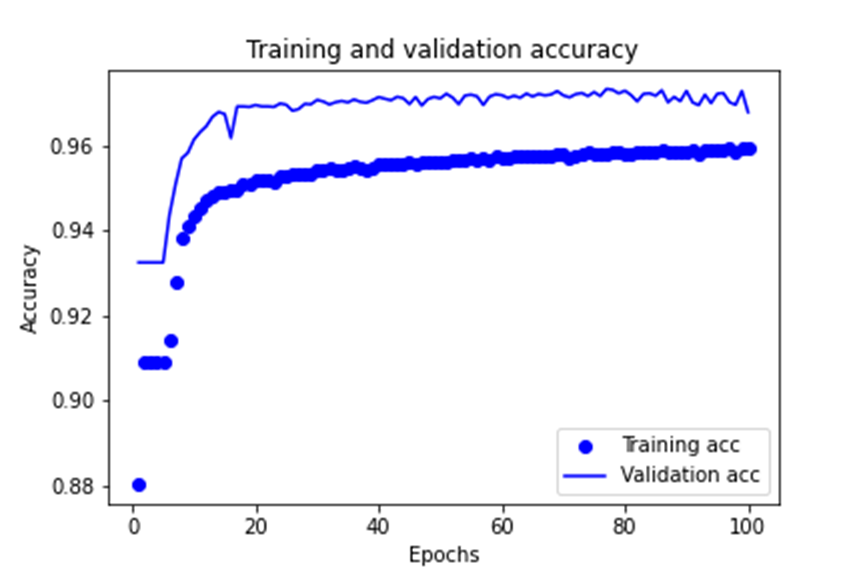
测试图像的预测结果与原图的对比结果,如下图所示。其中,左侧为预测结果,右侧为真实图像。

【2】UNet L2模型训练
采用【model.summary()】代码,输出UNet L2模型的详细结构,结果如下图所示。分析可知,本次训练的参数量为581666。


而后,模型采用Adam作为优化器,0.001作为初始学习率,交叉熵函数作为损失函数。在模型训练过程中,采用64作为批大小,100作为迭代次数。训练集和验证集的比例为8:2。
训练过程中的训练集和验证集上的损失值,如下图所示。

训练过程中的训练集和验证集上的准确率,如下图所示。

测试图像的预测结果与原图的对比结果,如下图所示。其中,左侧为预测结果,右侧为真实图像。

【3】UNet L3模型训练
采用【model.summary()】代码,输出UNet L3模型的详细结构,结果如下图所示。分析可知,本次训练的参数量为2536418。


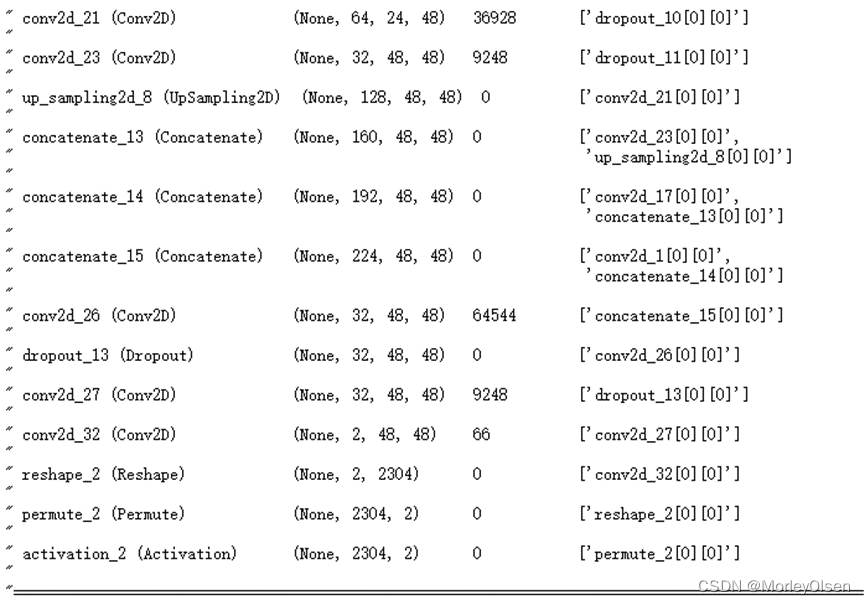
而后,模型采用Adam作为优化器,0.001作为初始学习率,交叉熵函数作为损失函数。在模型训练过程中,采用64作为批大小,100作为迭代次数。训练集和验证集的比例为8:2。
训练过程中的训练集和验证集上的损失值,如下图所示。

训练过程中的训练集和验证集上的准确率,如下图所示。
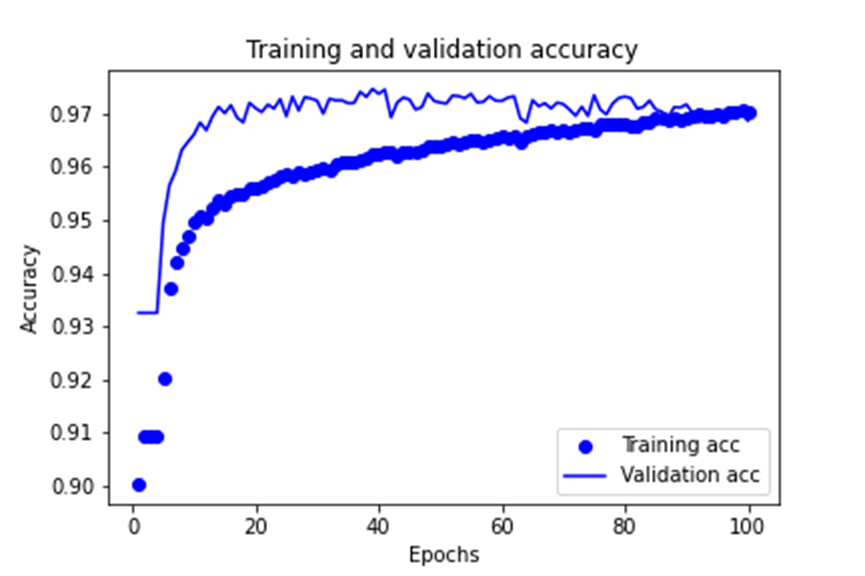
测试图像的预测结果与原图的对比结果,如下图所示。其中,左侧为预测结果,右侧为真实图像。
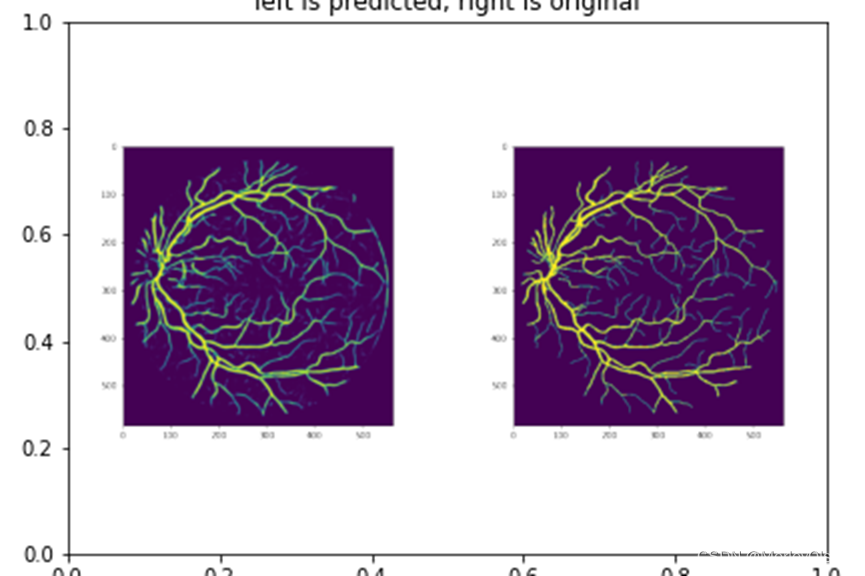
【4】UNet L4模型训练
采用【model.summary()】代码,输出UNet L4模型的详细结构,结果如下图所示。分析可知,本次训练的参数量为10436514。




而后,模型采用Adam作为优化器,0.001作为初始学习率,交叉熵函数作为损失函数。在模型训练过程中,采用64作为批大小,100作为迭代次数。训练集和验证集的比例为8:2。
训练过程中的训练集和验证集上的损失值,如下图所示。

训练过程中的训练集和验证集上的准确率,如下图所示。
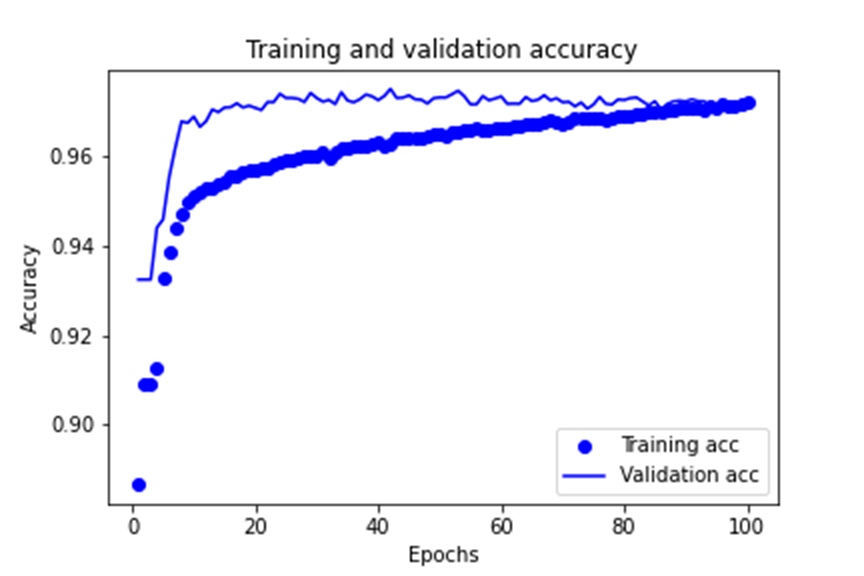
测试图像的预测结果与原图的对比结果,如下图所示。其中,左侧为预测结果,右侧为真实图像。

3:UNet++模型分析
UNet++中的关键代码如下表所示,即模型结构的搭建。
defconv_block(input_tensor, num_filters):
"""构造一个简单的卷积块,包含两个卷积层"""
x = Conv2D(num_filters, (3, 3), activation='relu', padding='same', data_format='channels_first')(input_tensor)
x = Dropout(0.2)(x)
x = Conv2D(num_filters, (3, 3), activation='relu', padding='same', data_format='channels_first')(x)
returnx
defunet_pp(n_ch, patch_height, patch_width):
inputs = Input(shape=(n_ch, patch_height, patch_width))
# 编码路径
x00 = conv_block(inputs, 32)
p0 = MaxPooling2D((2, 2))(x00)
x10 = conv_block(p0, 64)
p1 = MaxPooling2D((2, 2))(x10)
x20 = conv_block(p1, 128)
p2 = MaxPooling2D((2, 2))(x20)
x30 = conv_block(p2, 256)
p3 = MaxPooling2D((2, 2))(x30)
x40 = conv_block(p3, 512) # 最底层
# wtf 纯手写中间层啊,草
x40_up = UpSampling2D(size=(2, 2))(x40)
x40_up = concatenate([x30,x40_up],axis=1)
x31 = conv_block(x40_up, 256)
x30_up = UpSampling2D(size=(2, 2))(x30)
x30_up = concatenate([x20,x30_up],axis=1)
x21 = conv_block(x30_up, 128)
x20_up = UpSampling2D(size=(2, 2))(x20)
x20_up = concatenate([x10,x20_up],axis=1)
x11 = conv_block(x20_up, 64)
x10_up = UpSampling2D(size=(2, 2))(x10)
x10_up = concatenate([x00,x10_up],axis=1)
x01 = conv_block(x10_up, 32)
x31_up = UpSampling2D(size=(2, 2))(x31)
x31_up = concatenate([x21,x31_up],axis=1)
x31_up = concatenate([x20,x31_up],axis=1)
x22 = conv_block(x31_up, 128)
x21_up = UpSampling2D(size=(2, 2))(x21)
x21_up = concatenate([x11,x21_up],axis=1)
x21_up = concatenate([x10,x21_up],axis=1)
x12 = conv_block(x21_up, 64)
x11_up = UpSampling2D(size=(2, 2))(x11)
x11_up = concatenate([x01,x11_up],axis=1)
x11_up = concatenate([x00,x11_up],axis=1)
x02 = conv_block(x11_up, 32)
x22_up = UpSampling2D(size=(2, 2))(x22)
x22_up = concatenate([x12,x22_up],axis=1)
x22_up = concatenate([x11,x22_up],axis=1)
x22_up = concatenate([x10,x22_up],axis=1)
x13 = conv_block(x22_up, 64)
x12_up = UpSampling2D(size=(2, 2))(x12)
x12_up = concatenate([x02,x12_up],axis=1)
x12_up = concatenate([x01,x12_up],axis=1)
x12_up = concatenate([x00,x12_up],axis=1)
x03 = conv_block(x12_up, 32)
x13_up = UpSampling2D(size=(2, 2))(x13)
x13_up = concatenate([x03,x13_up],axis=1)
x13_up = concatenate([x02,x13_up],axis=1)
x13_up = concatenate([x01,x13_up],axis=1)
x13_up = concatenate([x00,x13_up],axis=1)
x04 = conv_block(x13_up, 32)
# 最终层
final_1 = Conv2D(2,(1,1),activation='relu',padding='same',data_format='channels_first')(x01)
final_1 = Reshape((2,patch_height*patch_width))(final_1)
final_1 = Permute((2,1))(final_1)
final_1 = Activation('softmax')(final_1)
final_2 = Conv2D(2,(1,1),activation='relu',padding='same',data_format='channels_first')(x02)
final_2 = Reshape((2,patch_height*patch_width))(final_2)
final_2 = Permute((2,1))(final_2)
final_2 = Activation('softmax')(final_2)
final_3 = Conv2D(2,(1,1),activation='relu',padding='same',data_format='channels_first')(x03)
final_3 = Reshape((2,patch_height*patch_width))(final_3)
final_3 = Permute((2,1))(final_3)
final_3 = Activation('softmax')(final_3)
final_4 = Conv2D(2,(1,1),activation='relu',padding='same',data_format='channels_first')(x04)
final_4 = Reshape((2,patch_height*patch_width))(final_4)
final_4 = Permute((2,1))(final_4)
final_4 = Activation('softmax')(final_4)
final = [final_1, final_2, final_3, final_4]
# Unet++ L4到L1需要manual modification。
model = Model(inputs=inputs, outputs=final_4)
returnmodel
4:尝试提高模型的精度
本节部分将着重探讨不同epoch下得到的训练结果在测试图像上的验证结果。
在UNet模型中,当epoch=10时,得到的测试图像预测结果如下图所示。根据预测结果可以分析得到:在训练迭代次数较低的情况下,模型并不能很好的对眼球图像进行分割,只能看到比较粗的血管的纹路。
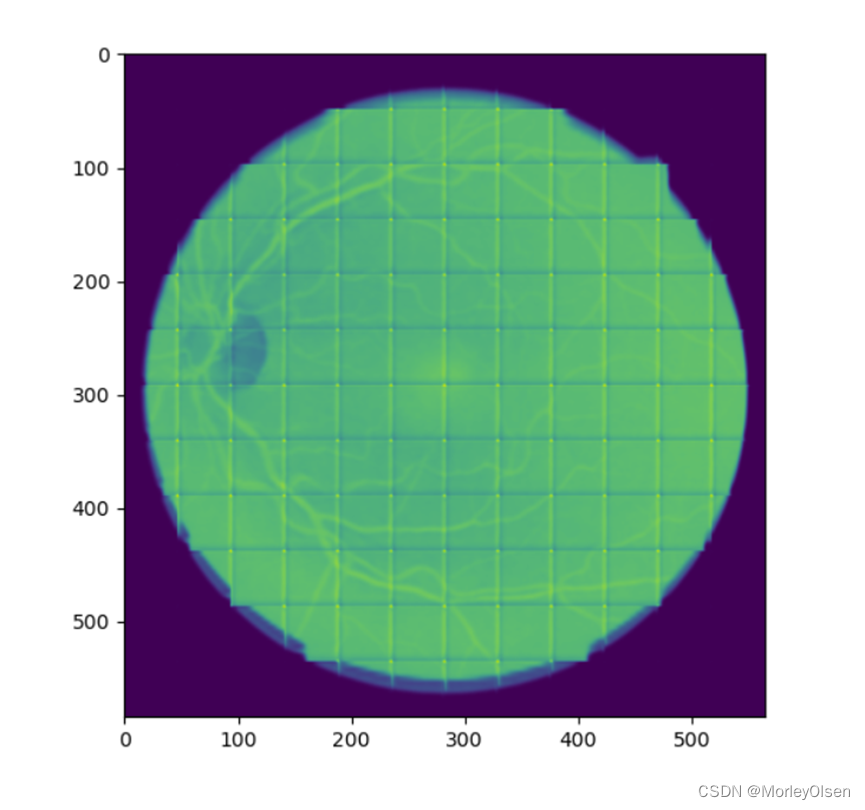
在UNet模型中,当epoch=40时,得到的测试图像预测结果如下图所示。根据预测结果可以分析得到:在训练迭代次数中等的情况下,模型能够基本完成对眼球图像进行分割,但是较细的血管仍然不可见。

在UNet模型中,当epoch=200时,得到的测试图像预测结果如下图所示。根据预测结果可以分析得到:在训练迭代次数较高的情况下,模型能够完全完成对眼球图像进行分割,所有眼球中的血管基本保持一个较高的能见度。
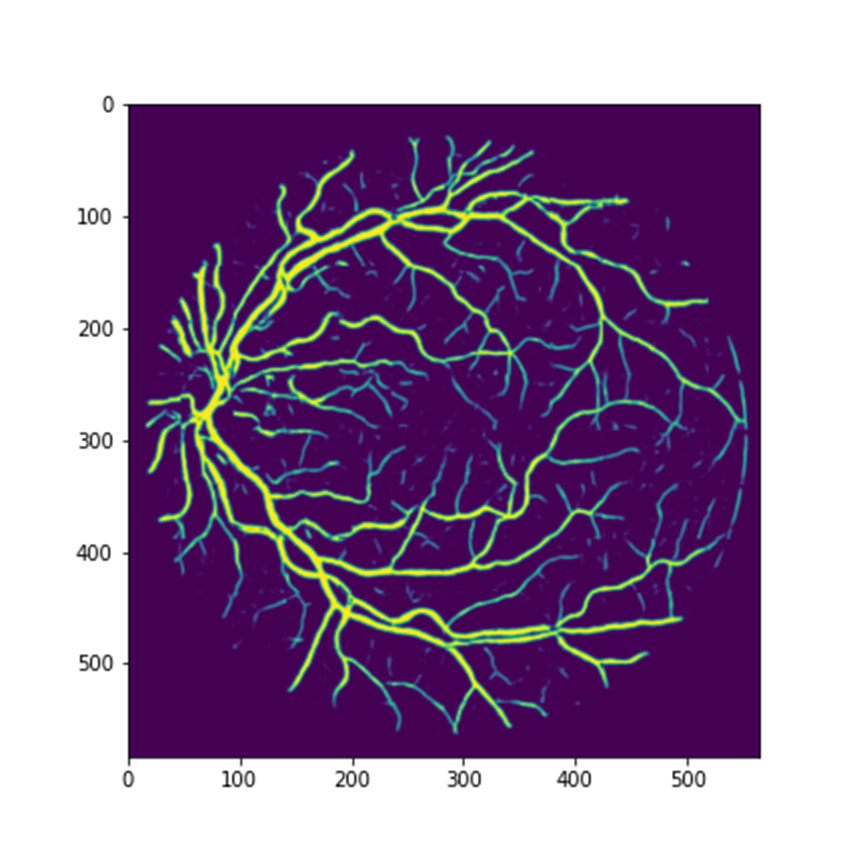
六:实验结论
1:UNet模型的网络结构,如下图所示。

2:UNet++模型中采用了L1到L4的子网络结构,且每个子网络的输出已经都是图像的分割结果。浅层的对小目标更敏感,深层对大目标更敏感,通过特征concat拼接到一起,可以整合二者的优点。
3:UNet模型和UNet++模型的参数量比较,如下图所示。
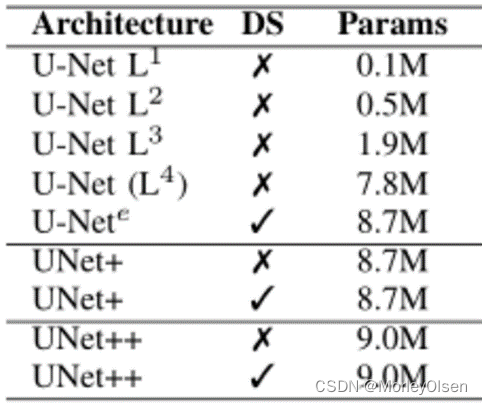
可以发现,UNet L4的参数 > UNet L3的参数 > UNet L2的参数 > UNet L1的参数。而真正实施的UNet++模型,通过pruning等方式,实现了参数的下降。
4:UNet系列模型中多次使用下采样和上采样。下采样可以增加对输入图像的一些小扰动的鲁棒性,比如图像平移,旋转等,减少过拟合的风险,降低运算量,增加感受野的大小。上采样可以把抽象的特征再还原解码到原图的尺寸,最终
得到分割结果。
5:浅层结构可以抓取图像的一些简单的特征,比如边界,颜色。深层结构因为感受野大,而且经过的卷积操作多,能抓取到图像的一些抽象特征。
七:遇到的问题和解决方法
问题1:运行代码时,出现dataset载入所调用的依赖包错误。
解决1:将transforms替换为torch中的模块,再进行图片的载入。
问题2:由于调用tensorflow包时,程序在训练过程中会显示【skip registering gpu】。即,无法正常调用gpu,只能调用cpu,因此训练速度非常慢。于是在服务器上尝试使用指令【pip install tensorflow-gpu】安装gpu版本的tensorflow,但是安装时出现以下报错。

解决2:尝试过conda指令安装【conda install tensorflow-gpu】、降低conda环境的python版本(conda create -n tfgpu python=3.8)和降低setuptools包的版本(如下图所示,参考自连接:https://blog.csdn.net/weixin_44244190/article/details/128863818),均未成功。因此,最后在AutoDL平台进行租借服务器进行训练,镜像采用TF基础镜像,后续配置完环境后可以调用gpu运行。
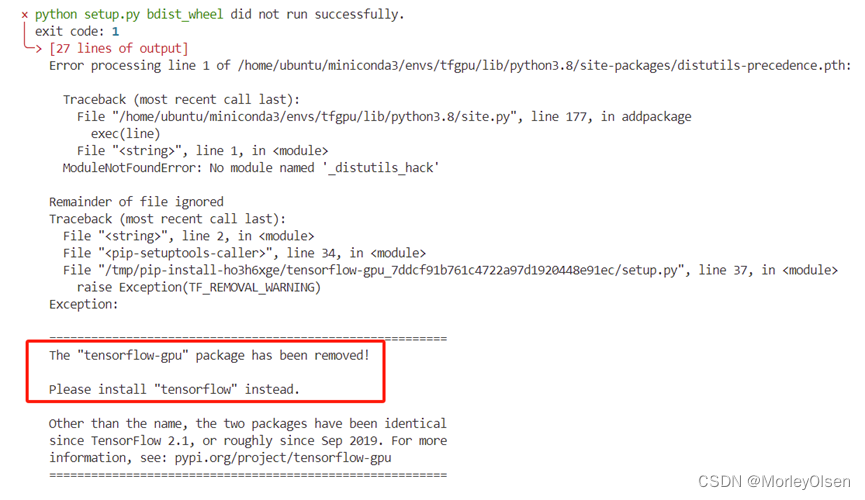
八:程序源代码
代码参考自:Unet简明代码实现眼底图像血管分割_unet网络进行眼底血管分割-CSDN博客,以下为最终实现的UNet模型和UNet++模型(或直接查看平台上的ipynb文件中的代码)。
UNet模型
importnumpyasnp
importcv2
fromPILimportImage
importmatplotlib.pyplotasplt
importos
fromkeras.modelsimportModel
fromkeras.layersimportInput, concatenate, Conv2D, MaxPooling2D, UpSampling2D, Reshape, Permute, Activation, Dropout
fromkeras.optimizersimportAdam, SGD
fromkeras.callbacksimportModelCheckpoint, LearningRateScheduler
fromkerasimportbackendasK
importtensorflowastf
config = tf.compat.v1.ConfigProto()
config.gpu_options.allow_growth = True
session = tf.compat.v1.Session(config=config)
img_x, img_y = (576, 576)
dx = 48
filelst = os.listdir(r'/home/ubuntu/DRIVE/training/images/')
filelst = ['DRIVE/training/images/'+vforvinfilelst]
imgs = [cv2.imread(file) forfileinfilelst]
filelst = os.listdir(r'/home/ubuntu/DRIVE/training/1st_manual/')
filelst = ['DRIVE/training/1st_manual/'+vforvinfilelst]
manuals = [np.asarray(Image.open(file)) forfileinfilelst]
imgs = [cv2.resize(v,(img_x, img_y)) forvinimgs]
manuals = [cv2.resize(v,(img_x, img_y)) forvinmanuals]
X_train = np.array(imgs)
Y_train = np.array(manuals)
X_train = X_train.astype('float32')/255.
Y_train = Y_train.astype('float32')/255.
X_train = X_train[...,1] # the G channel
X_train = np.array([[X_train[:,v*dx:(v+1)dx, vvdx:(vv+1)*dx] forvinrange(img_y//dx)] forvvinrange(img_x//dx)]).reshape(-1,dx,dx)[:,np.newaxis,...]
Y_train = np.array([[Y_train[:,v*dx:(v+1)dx, vvdx:(vv+1)dx] forvinrange(img_y//dx)] forvvinrange(img_x//dx)]).reshape(-1,dxdx)[...,np.newaxis]
temp = 1-Y_train
Y_train = np.concatenate([Y_train,temp],axis=2)
defunet_model(n_ch,patch_height,patch_width):
inputs = Input(shape=(n_ch,patch_height,patch_width))
conv1 = Conv2D(32, (3, 3), activation='relu', padding='same',data_format='channels_first')(inputs)
conv1 = Dropout(0.2)(conv1)
conv1 = Conv2D(32, (3, 3), activation='relu', padding='same',data_format='channels_first')(conv1)
pool1 = MaxPooling2D((2, 2))(conv1)
conv2 = Conv2D(64, (3, 3), activation='relu', padding='same',data_format='channels_first')(pool1)
conv2 = Dropout(0.2)(conv2)
conv2 = Conv2D(64, (3, 3), activation='relu', padding='same',data_format='channels_first')(conv2)
pool2 = MaxPooling2D((2, 2))(conv2)
conv3 = Conv2D(128, (3, 3), activation='relu', padding='same',data_format='channels_first')(pool2)
conv3 = Dropout(0.2)(conv3)
conv3 = Conv2D(128, (3, 3), activation='relu', padding='same',data_format='channels_first')(conv3)
up1 = UpSampling2D(size=(2, 2))(conv3)
up1 = concatenate([conv2,up1],axis=1)
conv4 = Conv2D(64, (3, 3), activation='relu', padding='same',data_format='channels_first')(up1)
conv4 = Dropout(0.2)(conv4)
conv4 = Conv2D(64, (3, 3), activation='relu', padding='same',data_format='channels_first')(conv4)
up2 = UpSampling2D(size=(2, 2))(conv4)
up2 = concatenate([conv1,up2], axis=1)
conv5 = Conv2D(32, (3, 3), activation='relu', padding='same',data_format='channels_first')(up2)
conv5 = Dropout(0.2)(conv5)
conv5 = Conv2D(32, (3, 3), activation='relu', padding='same',data_format='channels_first')(conv5)
conv6 = Conv2D(2, (1, 1), activation='relu',padding='same',data_format='channels_first')(conv5)
conv6 = Reshape((2,patch_height*patch_width))(conv6)
conv6 = Permute((2,1))(conv6)
conv7 = Activation('softmax')(conv6)
model = Model(inputs=inputs, outputs=conv7)
returnmodel
model = unet_model(X_train.shape[1],X_train.shape[2],X_train.shape[3])
model.summary()
checkpointer = ModelCheckpoint(filepath='best_weights.h5', verbose=1, monitor='val_acc',
mode='auto', save_best_only=True)
model.compile(optimizer=Adam(lr=0.001), loss='categorical_crossentropy',metrics=['accuracy'])
modify epoch!!!!!!!!!!!!!!!!!!!!!!!!!
model.fit(X_train, Y_train, batch_size=64, epochs=200, verbose=2,shuffle=True, validation_split=0.2,
callbacks=[checkpointer])
imgs = cv2.imread(r'/home/ubuntu/DRIVE/test/images/01_test.tif')[...,1] #the G channel
imgs = cv2.resize(imgs,(img_x, img_y))
manuals = np.asarray(Image.open(r'/home/ubuntu/DRIVE/test/1st_manual/01_manual1.gif'))
X_test = imgs.astype('float32')/255.
Y_test = manuals.astype('float32')/255.
X_test = np.array([[X_test[v*dx:(v+1)dx, vvdx:(vv+1)*dx] forvinrange(img_y//dx)] forvvinrange(img_x//dx)]).reshape(-1,dx,dx)[:,np.newaxis,...]
model.load_weights('best_weights.h5')
Y_pred = model.predict(X_test)
Y_pred = Y_pred[...,0].reshape(img_x//dx,img_y//dx,dx,dx)
Y_pred = [Y_pred[:,v,...] forvinrange(img_x//dx)]
Y_pred = np.concatenate(np.concatenate(Y_pred,axis=1),axis=1)
Y_pred = cv2.resize(Y_pred,(Y_test.shape[1], Y_test.shape[0]))
plt.figure(figsize=(6,6))
plt.imshow(Y_pred)
plt.savefig('predicted_image.png') # 保存预测的图像
plt.close() # 关闭当前图形以释放内存
plt.figure(figsize=(6,6))
plt.imshow(Y_test)
plt.savefig('ground_truth_image.png') # 保存真实的图像
plt.close() # 关闭当前图形以释放内存
UNet++模型
importnumpyasnp
importcv2
fromPILimportImage
importmatplotlib.pyplotasplt
importos
fromkeras.modelsimportModel
fromkeras.layersimportInput, concatenate, Conv2D, MaxPooling2D, UpSampling2D, Reshape, Permute, Activation, Dropout
fromkeras.optimizersimportAdam, SGD
fromkeras.callbacksimportModelCheckpoint, LearningRateScheduler
fromkerasimportbackendasK
importtensorflowastf
config = tf.compat.v1.ConfigProto()
config.gpu_options.allow_growth = True
session = tf.compat.v1.Session(config=config)
img_x, img_y = (576, 576)
dx = 48
filelst = os.listdir(r'/home/ubuntu/DRIVE/training/images/')
filelst = ['DRIVE/training/images/'+vforvinfilelst]
imgs = [cv2.imread(file) forfileinfilelst]
filelst = os.listdir(r'/home/ubuntu/DRIVE/training/1st_manual/')
filelst = ['DRIVE/training/1st_manual/'+vforvinfilelst]
manuals = [np.asarray(Image.open(file)) forfileinfilelst]
imgs = [cv2.resize(v,(img_x, img_y)) forvinimgs]
manuals = [cv2.resize(v,(img_x, img_y)) forvinmanuals]
X_train = np.array(imgs)
Y_train = np.array(manuals)
X_train = X_train.astype('float32')/255.
Y_train = Y_train.astype('float32')/255.
X_train = X_train[...,1] # the G channel
X_train = np.array([[X_train[:,v*dx:(v+1)dx, vvdx:(vv+1)*dx] forvinrange(img_y//dx)] forvvinrange(img_x//dx)]).reshape(-1,dx,dx)[:,np.newaxis,...]
Y_train = np.array([[Y_train[:,v*dx:(v+1)dx, vvdx:(vv+1)dx] forvinrange(img_y//dx)] forvvinrange(img_x//dx)]).reshape(-1,dxdx)[...,np.newaxis]
temp = 1-Y_train
Y_train = np.concatenate([Y_train,temp],axis=2)
print("X_train shape:", X_train.shape)
print("Y_train shape:", Y_train.shape)
defconv_block(input_tensor, num_filters):
"""构造一个简单的卷积块,包含两个卷积层"""
x = Conv2D(num_filters, (3, 3), activation='relu', padding='same', data_format='channels_first')(input_tensor)
x = Dropout(0.2)(x)
x = Conv2D(num_filters, (3, 3), activation='relu', padding='same', data_format='channels_first')(x)
returnx
defunet_pp(n_ch, patch_height, patch_width):
inputs = Input(shape=(n_ch, patch_height, patch_width))
# 编码路径
x00 = conv_block(inputs, 32)
p0 = MaxPooling2D((2, 2))(x00)
x10 = conv_block(p0, 64)
p1 = MaxPooling2D((2, 2))(x10)
x20 = conv_block(p1, 128)
p2 = MaxPooling2D((2, 2))(x20)
x30 = conv_block(p2, 256)
p3 = MaxPooling2D((2, 2))(x30)
x40 = conv_block(p3, 512) # 最底层
# wtf 纯手写中间层啊,草
x40_up = UpSampling2D(size=(2, 2))(x40)
x40_up = concatenate([x30,x40_up],axis=1)
x31 = conv_block(x40_up, 256)
x30_up = UpSampling2D(size=(2, 2))(x30)
x30_up = concatenate([x20,x30_up],axis=1)
x21 = conv_block(x30_up, 128)
x20_up = UpSampling2D(size=(2, 2))(x20)
x20_up = concatenate([x10,x20_up],axis=1)
x11 = conv_block(x20_up, 64)
x10_up = UpSampling2D(size=(2, 2))(x10)
x10_up = concatenate([x00,x10_up],axis=1)
x01 = conv_block(x10_up, 32)
x31_up = UpSampling2D(size=(2, 2))(x31)
x31_up = concatenate([x21,x31_up],axis=1)
x31_up = concatenate([x20,x31_up],axis=1)
x22 = conv_block(x31_up, 128)
x21_up = UpSampling2D(size=(2, 2))(x21)
x21_up = concatenate([x11,x21_up],axis=1)
x21_up = concatenate([x10,x21_up],axis=1)
x12 = conv_block(x21_up, 64)
x11_up = UpSampling2D(size=(2, 2))(x11)
x11_up = concatenate([x01,x11_up],axis=1)
x11_up = concatenate([x00,x11_up],axis=1)
x02 = conv_block(x11_up, 32)
x22_up = UpSampling2D(size=(2, 2))(x22)
x22_up = concatenate([x12,x22_up],axis=1)
x22_up = concatenate([x11,x22_up],axis=1)
x22_up = concatenate([x10,x22_up],axis=1)
x13 = conv_block(x22_up, 64)
x12_up = UpSampling2D(size=(2, 2))(x12)
x12_up = concatenate([x02,x12_up],axis=1)
x12_up = concatenate([x01,x12_up],axis=1)
x12_up = concatenate([x00,x12_up],axis=1)
x03 = conv_block(x12_up, 32)
x13_up = UpSampling2D(size=(2, 2))(x13)
x13_up = concatenate([x03,x13_up],axis=1)
x13_up = concatenate([x02,x13_up],axis=1)
x13_up = concatenate([x01,x13_up],axis=1)
x13_up = concatenate([x00,x13_up],axis=1)
x04 = conv_block(x13_up, 32)
# 最终层
final_1 = Conv2D(2,(1,1),activation='relu',padding='same',data_format='channels_first')(x01)
final_1 = Reshape((2,patch_height*patch_width))(final_1)
final_1 = Permute((2,1))(final_1)
final_1 = Activation('softmax')(final_1)
final_2 = Conv2D(2,(1,1),activation='relu',padding='same',data_format='channels_first')(x02)
final_2 = Reshape((2,patch_height*patch_width))(final_2)
final_2 = Permute((2,1))(final_2)
final_2 = Activation('softmax')(final_2)
final_3 = Conv2D(2,(1,1),activation='relu',padding='same',data_format='channels_first')(x03)
final_3 = Reshape((2,patch_height*patch_width))(final_3)
final_3 = Permute((2,1))(final_3)
final_3 = Activation('softmax')(final_3)
final_4 = Conv2D(2,(1,1),activation='relu',padding='same',data_format='channels_first')(x04)
final_4 = Reshape((2,patch_height*patch_width))(final_4)
final_4 = Permute((2,1))(final_4)
final_4 = Activation('softmax')(final_4)
final = [final_1, final_2, final_3, final_4]
# Unet++ L4到L1需要manual modification。
model = Model(inputs=inputs, outputs=final_4)
returnmodel
model = unet_pp(X_train.shape[1],X_train.shape[2],X_train.shape[3])
model.summary()
mode = 'auto'
checkpointer = ModelCheckpoint(filepath='best_weights.h5', verbose=1, monitor='val_acc', mode='max', save_best_only=True)
model.compile(optimizer=Adam(lr=0.001), loss='categorical_crossentropy',metrics=['accuracy'])
modify epoch!!!!!!!!!!!!!!!!!!!!!!!!!
model.fit(X_train, Y_train, batch_size=64, epochs=1, verbose=2,shuffle=True, validation_split=0.2, callbacks=[checkpointer])
imgs = cv2.imread(r'/home/ubuntu/DRIVE/test/images/01_test.tif')[...,1] #the G channel
imgs = cv2.resize(imgs,(img_x, img_y))
manuals = np.asarray(Image.open(r'/home/ubuntu/DRIVE/test/1st_manual/01_manual1.gif'))
X_test = imgs.astype('float32')/255.
Y_test = manuals.astype('float32')/255.
X_test = np.array([[X_test[v*dx:(v+1)dx, vvdx:(vv+1)*dx] forvinrange(img_y//dx)] forvvinrange(img_x//dx)]).reshape(-1,dx,dx)[:,np.newaxis,...]
print("X_test shape:", X_test.shape)
print("input shape:", model.input_shape)
print("output shape:", model.output_shape)
model.load_weights('best_weights.h5')
Y_pred = model.predict(X_test)
Y_pred = Y_pred[...,0].reshape(img_x//dx,img_y//dx,dx,dx)
Y_pred = [Y_pred[:,v,...] forvinrange(img_x//dx)]
Y_pred = np.concatenate(np.concatenate(Y_pred,axis=1),axis=1)
Y_pred = cv2.resize(Y_pred,(Y_test.shape[1], Y_test.shape[0]))
plt.figure(figsize=(6,6))
plt.imshow(Y_pred)
plt.savefig('unetpp_predicted_image.png') # 保存预测的图像
plt.close() # 关闭当前图形以释放内存
plt.figure(figsize=(6,6))
plt.imshow(Y_test)
plt.savefig('unetpp_ground_truth_image.png') # 保存真实的图像
plt.close() # 关闭当前图形以释放内存
版权归原作者 MorleyOlsen 所有, 如有侵权,请联系我们删除。